Ecological Gifts Program for Ontario – Donor and recipient profiles
Do you own land that contains natural habitat, such as a forest, prairie, wetland or shoreline? Would you like to see it protected for future generations?
Through the Government of Canada’s Ecological Gifts Program, landowners can donate their land, or a partial interest such as a conservation easement agreement, to an eligible recipient organization that will care for it forever, such as a land trust, conservation organization, or government. In addition to the peace of mind that the land will be forever protected, donors can receive significant income tax benefits including elimination of any tax on the capital gain.
For more information, visit the Ecological Gifts Program website.
Recipient profile
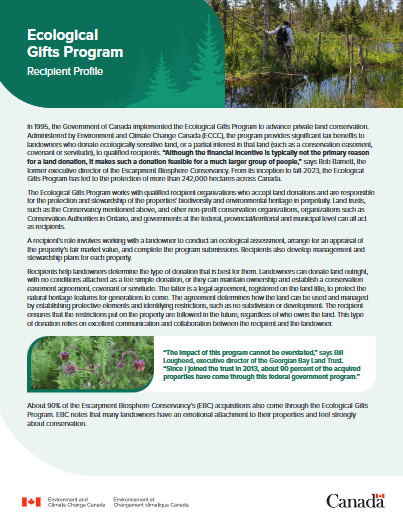
Download the alternative format
(PDF format, 2281 KB, 2 pages)
In 1995, the Government of Canada implemented the Ecological Gifts Program to advance private land conservation. Administered by Environment and Climate Change Canada (ECCC), the program provides significant tax benefits to landowners who donate ecologically sensitive land, or a partial interest in that land (such as a conservation easement, covenant or servitude), to qualified recipients. “Although the financial incentive is typically not the primary reason for a land donation, it makes such a donation feasible for a much larger group of people,” says Bob Barnett, the former executive director of the Escarpment Biosphere Conservancy. From its inception to fall-2023, the Ecological Gifts Program has led to the protection of more than 242,000 hectares across Canada.
The Ecological Gifts Program works with qualified recipient organizations who accept land donations and are responsible for the protection and stewardship of the properties’ biodiversity and environmental heritage in perpetuity. Land trusts, such as the Conservancy mentioned above, and other non-profit conservation organizations, organizations such as Conservation Authorities in Ontario, and governments at the federal, provincial/territorial and municipal level can all act as recipients.
A recipient’s role involves working with a landowner to conduct an ecological assessment, arrange for an appraisal of the property’s fair market value, and complete the program submissions. Recipients also develop management and stewardship plans for each property.
Recipients help landowners determine the type of donation that is best for them. Landowners can donate land outright, with no conditions attached as a fee simple donation, or they can maintain ownership and establish a conservation easement agreement, covenant or servitude. The latter is a legal agreement, registered on the land title, to protect the natural heritage features for generations to come. The agreement determines how the land can be used and managed by establishing protective elements and identifying restrictions, such as no subdivision or development. The recipient ensures that the restrictions put on the property are followed in the future, regardless of who owns the land. This type of donation relies on excellent communication and collaboration between the recipient and the landowner.
“The impact of this program cannot be overstated,” says Bill Lougheed, executive director of the Georgian Bay Land Trust. “Since I joined the trust in 2013, about 90% of the acquired properties have come through this federal government program.”
About 90% of the Escarpment Biosphere Conservancy’s (EBC) acquisitions also come through the Ecological Gifts Program. EBC notes that many landowners have an emotional attachment to their properties and feel strongly about conservation.
They are thrilled to learn that the Ecological Gifts Program allows them to protect nature, leave a legacy for future generations, set ownership and access terms, and receive significant income tax benefits. Individuals, corporations, estates and trusts can all participate as donors in this program.
Dan Cooper, director of Conservation Lands and Stewardship at Rideau Valley Conservation Authority, appreciates how the program brings together citizens, organizations and governments around a common goal. “It’s one of the program’s greatest strengths because it demonstrates that we all have a role to play in land conservation, and that collaboration and coordination lead to faster and bigger success.”
Recipients of Ecological Gifts are responsible for maintaining the biodiversity and environmental heritage values of the property forever.
Adam Biddle, supervisor of Forestry, Parks and Operations for Norfolk County, commends the Ecological Gifts Program for its high standards for land appraisals and management plans. “The collected baseline data and plans required as part of the application process set us up for long-term success,” he says. “Program staff want donations to succeed, and are there to answer questions and assist with tasks through the entire process.”
Susan Walmer, CEO of the Oak Ridges Moraine Land Trust, has guided many landowners through the donation process, and many others through the purchase of land with conservation agreements already on title. “The Ecological Gifts Program gives landowners an opportunity to do what’s right for their families, communities and Canada,” she says. “It connects them to a critical mission.”
Conservation Easement Agreement Donation within the UNESCO Georgian Bay Biosphere Reserve
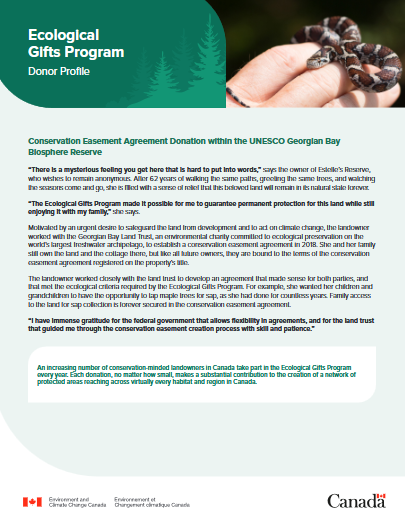
Download the alternative format
(PDF format, 1244 KB, 2 pages)
“There is a mysterious feeling you get here that is hard to put into words,” says the owner of Estelle’s Reserve, who wishes to remain anonymous. After 62 years of walking the same paths, greeting the same trees, and watching the seasons come and go, she is filled with a sense of relief that this beloved land will remain in its natural state forever.
“The Ecological Gifts Program made it possible for me to guarantee permanent protection for this land while still enjoying it with my family,” she says.
Motivated by an urgent desire to safeguard the land from development and to act on climate change, the landowner worked with the Georgian Bay Land Trust, an environmental charity committed to ecological preservation on the world’s largest freshwater archipelago, to establish a conservation easement agreement in 2018. She and her family still own the land and the cottage there, but like all future owners, they are bound to the terms of the conservation easement agreement registered on the property’s title.
The landowner worked closely with the land trust to develop an agreement that made sense for both parties, and that met the ecological criteria required by the Ecological Gifts Program. For example, she wanted her children and grandchildren to have the opportunity to tap maple trees for sap, as she had done for countless years. Family access to the land for sap collection is forever secured in the conservation easement agreement.
“I have immense gratitude for the federal government that allows flexibility in agreements, and for the land trust that guided me through the conservation easement creation process with skill and patience.”
An increasing number of conservation-minded landowners in Canada take part in the Ecological Gifts Program every year. Each donation, no matter how small, makes a substantial contribution to the creation of a network of protected areas reaching across virtually every habitat and region in Canada.
According to the Georgian Bay Land Trust, this reserve contributes greatly to the protection of nature in the area. Estelle’s Reserve is within the UNESCO Georgian Bay Biosphere Reserve and is near 3 other land trust properties. These properties create a valuable wildlife corridor and contribute to a protected areas network.
Covering more than 54 hectares, the property contains extensive mixed forests that support breeding bird species that require interior forest habitat, including the red-shouldered hawk. It also contains large expanses of treed rock barrens and wetlands supporting numerous snake and turtle species.
Blackstone Lake borders the eastern part of Estelle’s Reserve. Besides providing an ideal swimming experience, this cold inland body of water supports an abundance of lake trout. The conservation easement agreement prohibits new buildings and shoreline destruction of any kind, thereby protecting both swimming and fish-spawning habitat.
Conservation Easement Agreement and Fee Simple Donation on the Saugeen Peninsula, also known as the North Bruce
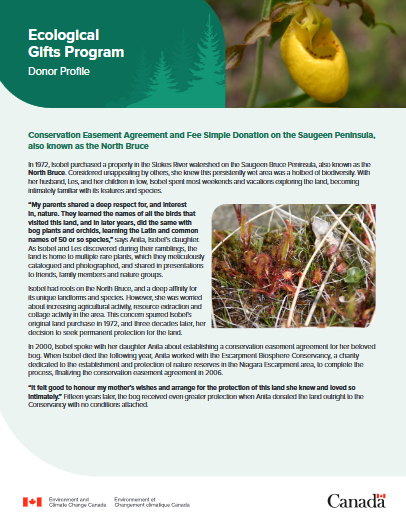
Download the alternative format
(PDF format, 1870 KB, 2 pages)
In 1972, Isobel purchased a property in the Stokes River watershed on the Saugeen Bruce Peninsula, also known as the North Bruce. Considered unappealing by others, she knew this persistently wet area was a hotbed of biodiversity. With her husband, Les, and her children in tow, Isobel spent most weekends and vacations exploring the land, becoming intimately familiar with its features and species.
“My parents shared a deep respect for, and interest in, nature. They learned the names of all the birds that visited this land, and in later years, did the same with bog plants and orchids, learning the Latin and common names of 50 or so species,” says Anita, Isobel’s daughter. As Isobel and Les discovered during their ramblings, the land is home to multiple rare plants, which they meticulously catalogued and photographed, and shared in presentations to friends, family members and nature groups.
Isobel had roots on the North Bruce, and a deep affinity for its unique landforms and species. However, she was worried about increasing agricultural activity, resource extraction and cottage activity in the area. This concern spurred Isobel’s original land purchase in 1972, and 3 decades later, her decision to seek permanent protection for the land.
In 2000, Isobel spoke with her daughter Anita about establishing a conservation easement agreement for her beloved bog. When Isobel died the following year, Anita worked with the Escarpment Biosphere Conservancy, a charity dedicated to the establishment and protection of nature reserves in the Niagara Escarpment area, to complete the process, finalizing the conservation easement agreement in 2006.
“It felt good to honour my mother’s wishes and arrange for the protection of this land she knew and loved so intimately.” Fifteen years later, the bog received even greater protection when Anita donated the land outright to the Conservancy with no conditions attached.
Detailed information on the tax benefits of the Ecological Gifts Program can be found in the publication Donation and Income Tax Scenarios, available on the EGP website.
Other incentives to donate through the EGP:
- The value of the donated property can be determined by the federal Minister of the Environment before the decision to proceed with the gift is made
- The donated property is protected and preserved in perpetuity
The Escarpment Biosphere Conservancy was thrilled to receive this land through the Ecological Gifts Program. At 11 hectares, the property may not be particularly large, but is strategically placed within the boundaries of a provincially significant wetland and provincial area of natural and scientific interest. In addition, it is located near many other reserves belonging to the Conservancy, making it a central part of the escarpment’s natural heritage network.
Anita is steadfast in her support for the Ecological Gifts Program. “I couldn’t recommend it more. Knowing this land will remain in its wild state, and be forever in the care of conservation experts, brings me great piece of mind. It’s exactly what my mother would have wanted.”
Fee Simple Donation in Norfolk County
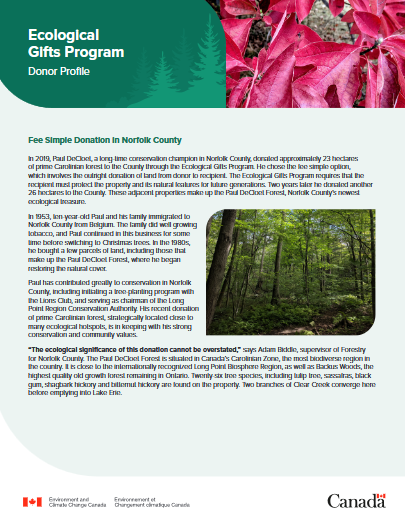
Download the alternative format
(PDF format, 1605 KB, 2 pages)
In 2019, Paul DeCloet, a long-time conservation champion in Norfolk County, donated approximately 23 hectares of prime Carolinian forest to the County through the Ecological Gifts Program. He chose the fee simple option, which involves the outright donation of land from donor to recipient. The Ecological Gifts Program requires that the recipient must protect the property and its natural features for future generations. Two years later he donated another 26 hectares to the County. These adjacent properties make up the Paul DeCloet Forest, Norfolk County’s newest ecological treasure.
In 1953, 10-year-old Paul and his family immigrated to Norfolk County from Belgium. The family did well growing tobacco, and Paul continued in this business for some time before switching to Christmas trees. In the 1980s, he bought a few parcels of land, including those that make up the Paul DeCloet Forest, where he began restoring the natural cover.
Paul has contributed greatly to conservation in Norfolk County, including initiating a tree-planting program with the Lions Club, and serving as chairman of the Long Point Region Conservation Authority. His recent donation of prime Carolinian forest, strategically located close to many ecological hotspots, is in keeping with his strong conservation and community values.
“The ecological significance of this donation cannot be overstated,” says Adam Biddle, supervisor of Forestry for Norfolk County. The Paul DeCloet Forest is situated in Canada’s Carolinian Zone, the most biodiverse region in the country. It is close to the internationally recognized Long Point Biosphere Region, as well as Backus Woods, the highest quality old growth forest remaining in Ontario. Twenty-six tree species, including tulip tree, sassafras, black gum, shagbark hickory and bitternut hickory are found on the property. Two branches of Clear Creek converge here before emptying into Lake Erie.
Paul began discussions with his children about selling the property 15 years earlier. When exploring options with his accountant, he learned about the Ecological Gifts Program, which offers financial incentives to landowners wanting to protect ecologically significant land in perpetuity. Paul then approached his local municipality, Norfolk County, with an offer to donate the land outright through the program, rather than selling. His family was supportive of his decision.
Ecological Gifts are donations with preferential income tax treatment, and therefore have specific requirements above and beyond other kinds of donations. In order for an Ecological Gift to meet these requirements, the federal Minister of the Environment must certify the property as ecologically sensitive, approve the recipient who receives the Ecological Gift, and certify the fair market value of the donation.
Norfolk County had no experience acting as a recipient for the program, so it took time for Council to discuss and agree to the idea, and for staff to work out logistics. However, the end result is a dream come true for Paul – the land he lovingly and skillfully stewarded for 4 decades is forever protected. “This is my legacy; my gift to the County. I am very pleased with how it all worked out,” he says.
Barb Heidenreich spent her life exploring and protecting southern Ontario’s natural heritage. Barb’s connection to the land began in 1899 when her great-grandfather, Byron Edmund Walker, purchased a large tract of land on the shore of Lake Simcoe and placed it into a family trust. Eight generations have explored and protected the shoreline, savannah, forest and wildlife found on this land; the conservation ethic that has guided Barb’s choices throughout her life began here. Her enduring dedication to nature culminated in the permanent protection of 121 hectares of land through the federal government’s Ecological Gifts Program.
With help from the Oak Ridges Moraine Land Trust, a charitable organization that protects and stewards land on the moraine, Barb established conservation easement agreements on 3 properties. These conservation easements allowed Barb to set limits on land use and development, while continuing to own and access the land.
Each donation of land or a partial interest in land must be certified as ecologically sensitive according to specific national and provincial criteria before it can be included under the Ecological Gifts Program.
Ecologically sensitive lands are areas or sites that currently, or could, at some point in the future, contribute significantly to the conservation of Canada’s biodiversity and environmental heritage. Where ecologically sensitive land is a significant part of a larger parcel of land, the entire property donated usually qualifies as an Ecological Gift.
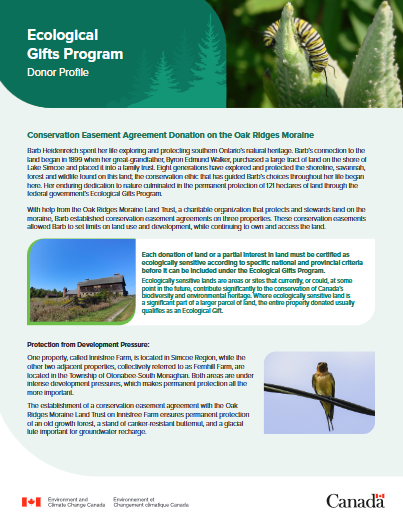
Download the alternative format
(PDF format, 700 KB, 2 pages)
Protection from development pressure
One property, called Innisfree Farm, is located in Simcoe Region, while the other 2 adjacent properties, collectively referred to as Fernhill Farm, are located in the Township of Otonabee-South Monaghan. Both areas are under intense development pressures, which makes permanent protection all the more important.
The establishment of a conservation easement agreement with the Oak Ridges Moraine Land Trust on Innisfree Farm ensures permanent protection of an old growth forest, a stand of canker-resistant butternut, and a glacial lute important for groundwater recharge.
Though the property recently changed ownership, the new owner and all future owners are bound by the terms of the conservation easement agreement registered on the property’s title, and must work with the recipient, the Oak Ridges Moraine Land Trust, to uphold its spirit and conditions. The land trust has considerable experience with landowner outreach and relations, as more than half of the properties they protect have conservation easements on their titles.
Barb also worked with the Oak Ridges Moraine Land Trust to establish a conservation easement agreement on Fernhill Farm near Rice Lake, which contains a mix of cultural heritage and geological features, agricultural fields, woodlands and wetlands.
The tax benefits offered by this program were a huge help in enabling me to protect the land I love for current and future generations of people and wildlife. I feel a great sense of relief and satisfaction knowing I’ve done all that I can for the land that has given me so much health and happiness.
Reflecting on her 2 experiences as a donor with the Ecological Gifts Program, Barb believes it is an excellent conservation tool for all types of landowners.
“There is so much flexibility to develop agreements that complement your values and meet your needs. I would encourage all conservation-minded landowners to investigate the program.”